Introduction
This section describes the message interactions that happen as part of the main booking workflow. It will define the key parameters and attributes required to progress through the booking flow.
Below is the primary data model that describes the key data items that are required.
Primary Data Model
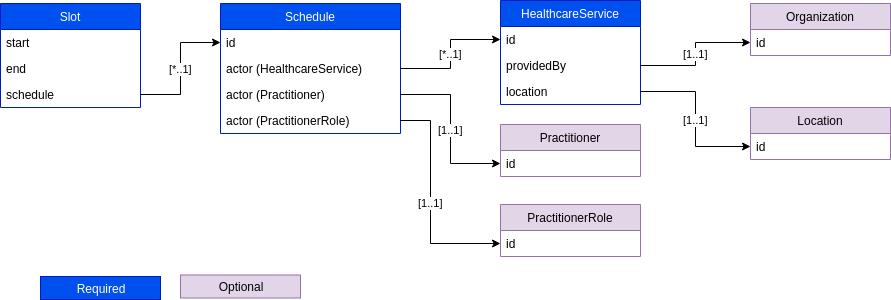
The sections below will step through the process.
How times should be handled
Please see the page on how times should be handled here.
The Actors
There are a number of different systems involved in the end to end booking process. These fall into the following catagories:
- Consumer System
- National Infrastructure
- Provider System
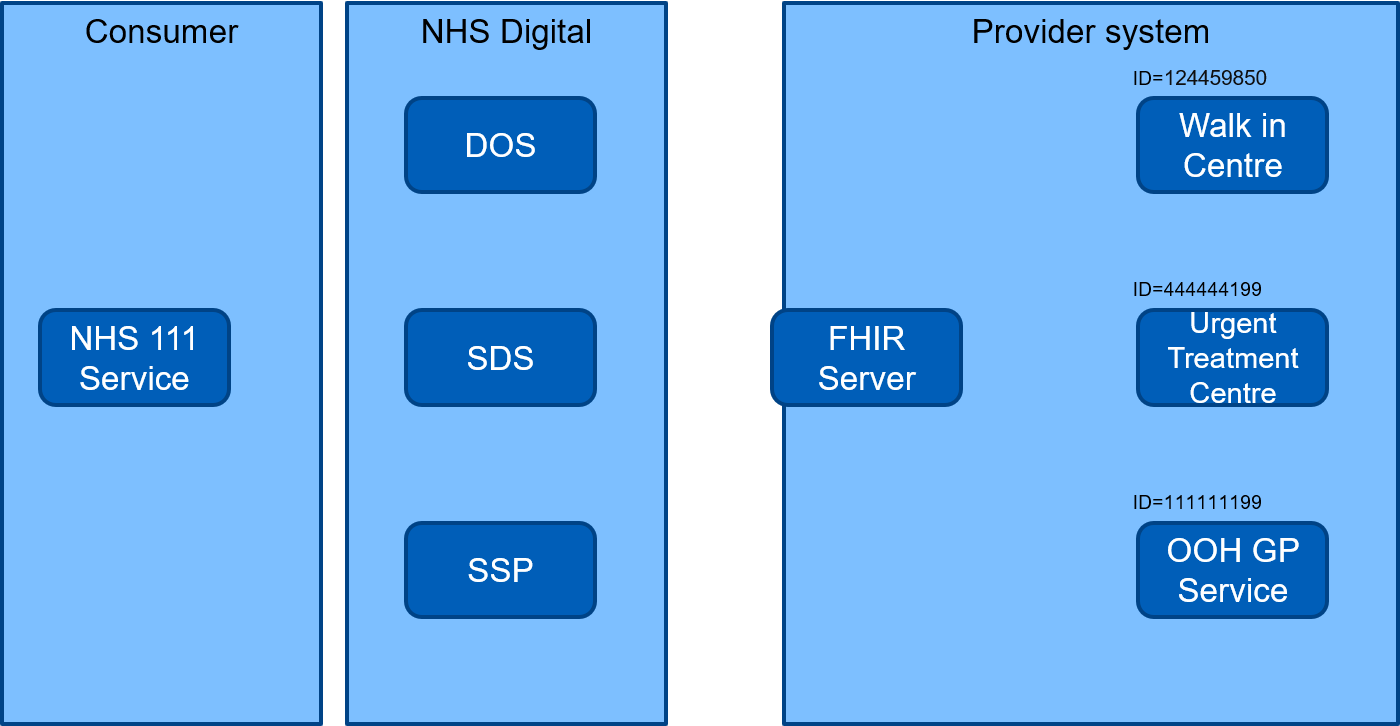
Consumer Systems
The Consumer System is the IT system that is being used by the service that is searching for an appropriate appointment for the patient. The system will participate in discovery of the appropriate service, discovery of its booking endpoint, searching the providing system for appropriate slots and then booking one of those slots for the patient.
National Infrastructure
During the booking process a number of systems that are hosted by NHS Digital as national infrastructure need to be interacted with. These are as follows:
Patient Demographic Service (PDS)
The Patient Demographic Service is a Spine service that enables matching captured demographics against a national demographic repository. PDS verified demographics, in particular NHS number is required by a lot of interoperability in the NHS. Although not a mandatory requirement it is reccomended that consumer systems attempt to obtain a spine verified NHS number, either by direct verification on PDS or through a Spine Mini Service Provider (SMSP) prior to attempting a booking.
National DoS
The national DoS can be used to discover the most appropriate service for the patient. If that service offers appointments the necessary information required to query SDS for the endpoint will be provided.
Spine Directory Service (SDS)
The SDS performs the role of the booking endpoint directory. Endpoints for the booking API of target provider systems will be registered on the SDS following assurance.
Spine Secure Proxy (SSP)
The SSP brokers and routes connections to endpoints. In order to facilitate urgent appointment booking it is important to support the ability to establish connections between systems on-the-fly without prior networking or security configuration between two specific systems. In order to do this all communications between systems are brokered via the SSP. That way systems involved in booking only ever need to establish and accept connections from/to the SSP which can be configured once, as part of assurance
Provider Systems
The provider system is the system that is offering bookings. This system will be configured to accept connections from the SSP and will offer the defined capabilities in this standard via its FHIR Interface. There are many different service types that could be a booking provider including ED’s, UTC’s, OOH GP’s, Emergency Dental services etc..
Service Discovery
The first step of the booking process involves some form of service discovery. Typically this will use a service discovery tool such as the Urgent Care Directory of Services (known as the “DoS”) to identify the most appropriate service to meet the patients needs.
Where the UEC DoS is being used there will be the initial call to the DoS API to return the ordered list of appropriate services (CheckCapacitySummary).
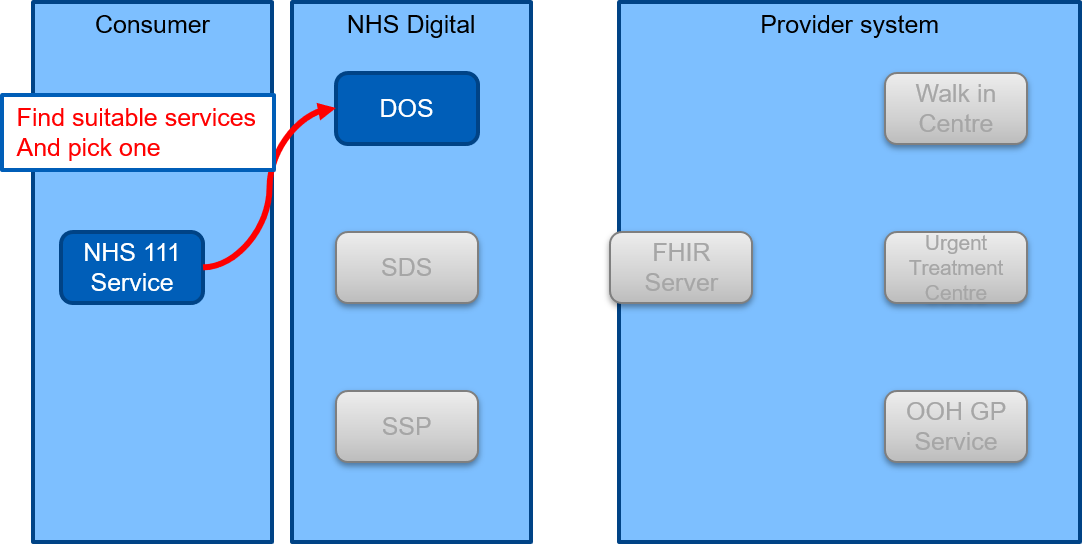
Once the chosen service has been selected the next call to the DoS API is made (ServiceDetailsByID) and this will return the specific details of the selected service including, where the service offers booking, something called an Accredited System Identifier (ASID).

An ASID is used to obtain the endpoint for booking into the Provider system. The DoS service ID would be used to identify the booking schedule in the Provider system.
Endpoint Discovery
The consumer system uses SDS to resolve the FHIR Endpoint Server Root URL. SDS is queried using the ASID obtained from the previous step.
This is a two step process:
- Obtaining the nhsAS object that contains an MHS Party Key.
- Obtaining the nhsMHS object that contains an nhsMHSEndPoint.
Step 1:
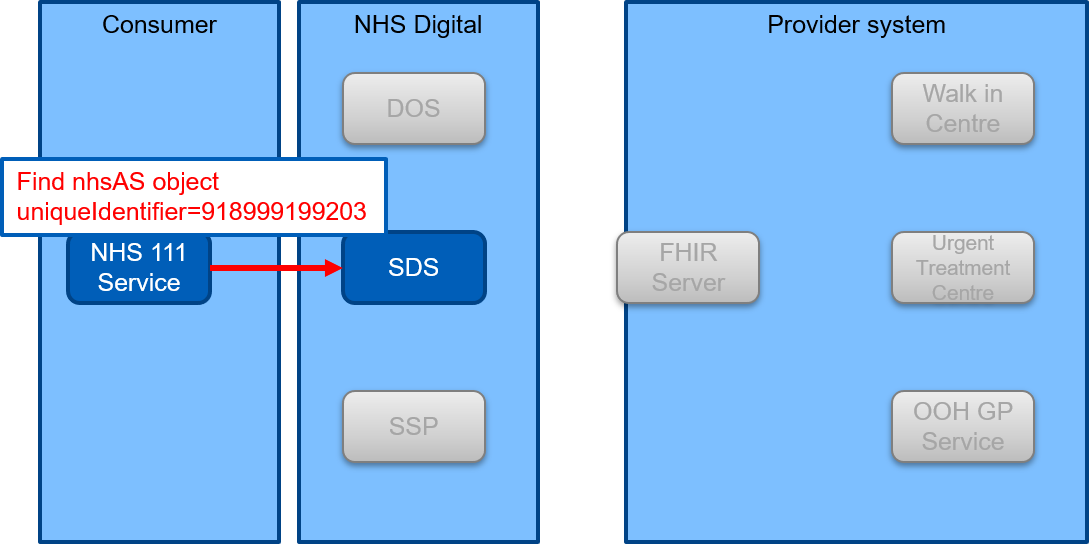
Given an ASID of 123456789012 a query can be made to obtain the nhsMHSPartyKey of the nhsAS object, for example:
ldapsearch -b uniqueIdentifier=123456789012,ou=Services,o=nhs nhsMHSPartyKey
Response:
nhsMHSPartyKey: A12345-1234567
The value returned is needed for step 2:
.png)
Step 2: A request for the nhsMHS object can then be made using the interaction and Party Key:
.png)
ldapsearch -b ou=Services,o=nhs "(&(nhsMHSPartyKey= A12345-1234567)(urn:nhs:names:services:careconnect:fhir:rest:create:appointment))" nhsMHSEndPoint
Response:
nhsMHSEndPoint: https://server.domain.nhs.uk/fhir_base
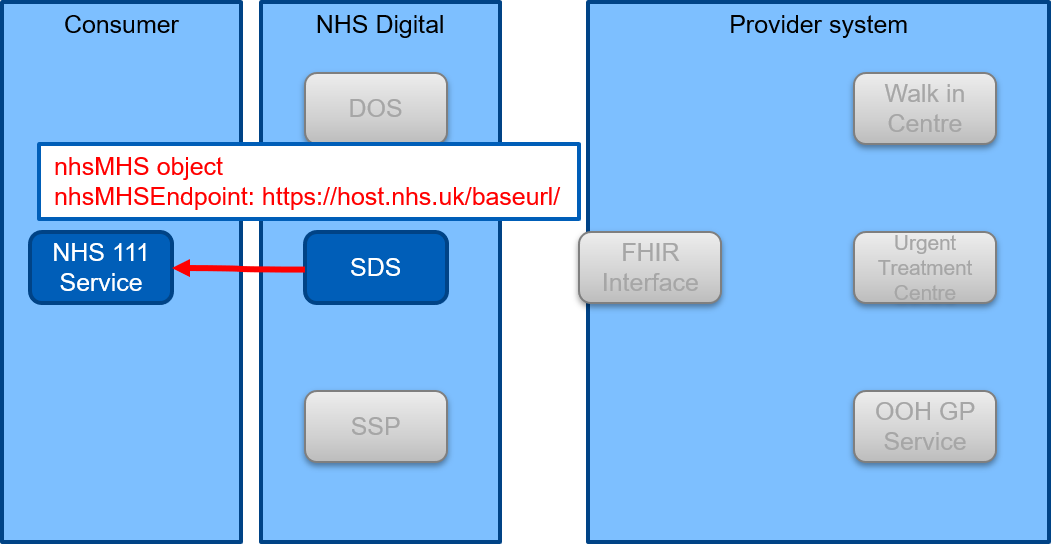
The value returned is the endpoint required to build an SSP request.
Authentication
Before making a call to the FHIR endpoint, the consumer system needs to generate an access token.
This access token is then passed in the Authorization http header in all calls to a provider system.
Using the access token the provider system can:
- Determine the identity of the consumer system.
- Be reassured that the consumer system has gone through the appropriate assurance to request slots and/or book appointments.
- Determine that the consumer system is involved in the provision of direct patient care (rather than for administrative purposes).
- Determine the care setting (e.g. urgent care, routine care Etc) for which the consumer system is requesting slots or making a booking.
More details on the authentication approach can be found here.
Get Slots
The first request to the SSP will be to get available slots. The request returns the slot resource from the target service. the request URL has three parts:
- The SSP proxy URL
- FHIR endpoint server root URL
- FHIR resource location and request parameters

Once the request is made at the SSP, it is passed through to the FHIR endpoint at the provider service.

This will return a FHIR slot resource bundle for example:
Click to expand!
{
"resourceType": "Bundle",
"type": "searchset",
"entry": [
{
"fullUrl": "Schedule/14",
"resource": {
"resourceType": "Schedule",
"id": "14",
"meta": {
"versionId": "1469444400000",
"profile": [
"https://fhir.nhs.uk/STU3/StructureDefinition/NHS-Schedule-1"
]
},
"actor": [
{
"reference": "Location/17"
},
{
"reference": "Practitioner/2"
}
],
"comment": "Schedule 1 for general appointments"
}
},
{
"fullUrl": "Practitioner/2",
"resource": {
"resourceType": "Practitioner",
"id": "2",
"meta": {
"versionId": "636064088099800115",
"profile": [
"https://fhir.nhs.uk/STU3/StructureDefinition/CareConnect-Practitioner-1"
]
},
"identifier": [
{
"system": "https://fhir.nhs.uk/Id/sds-user-id",
"value": "S001"
}
],
"name": {
"family": [ "Black" ],
"given": [ "Sarah" ],
"prefix": [ "Mrs" ]
},
"gender": "female"
}
},
{
"fullUrl": "Slot/1584",
"resource": {
"resourceType": "Slot",
"id": "1584",
"meta": {
"versionId": "1471219260000",
"profile": [
"https://fhir.nhs.uk/STU3/StructureDefinition/NHS-Slot-1"
]
},
"schedule": {
"reference": "Schedule/14"
},
"status": "free",
"start": "2016-08-15T11:30:00.000+01:00",
"end": "2016-08-15T11:59:59.000+01:00"
}
},
{
"fullUrl": "Slot/1644",
"resource": {
"resourceType": "Slot",
"id": "1644",
"meta": {
"versionId": "1471219260112",
"profile": [
"https://fhir.nhs.uk/STU3/StructureDefinition/NHS-Slot-1"
]
},
"schedule": {
"reference": "Schedule/14"
},
"status": "free",
"start": "2016-08-15T12:00:00.000+01:00",
"end": "2016-08-15T12:29:59.000+01:00"
}
}
]
}
Make Booking
The booking is made following a similar process as getting available slots. However this time a post is made to the SSP with a serialised FHIR appointment resource as the payload.

This will be passed through to the provider FHIR endpoint
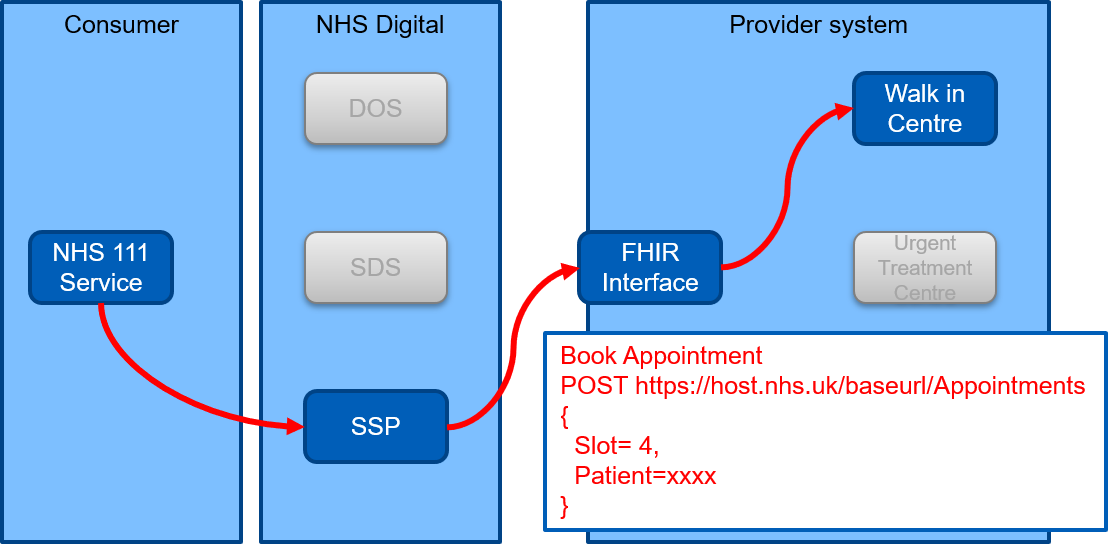
If a booking is successfully created a 201: Created HTTP status code will be returned.
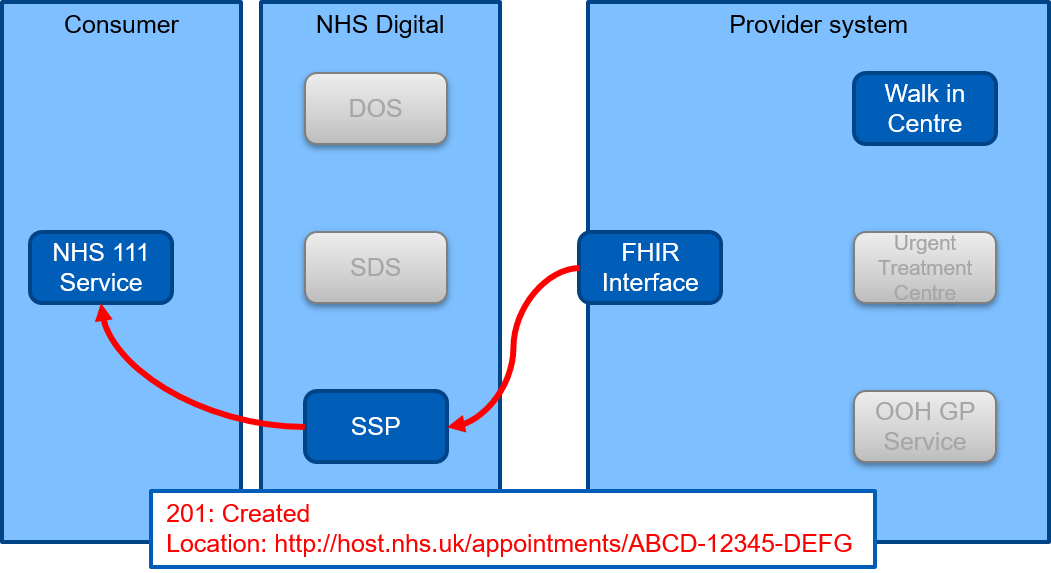
If the slot has been taken the response would have a 422 status as the request “…violated applicable FHIR profiles or server business rules”.
The response body would be an OperationOutcome containing an explanation of the problem.
